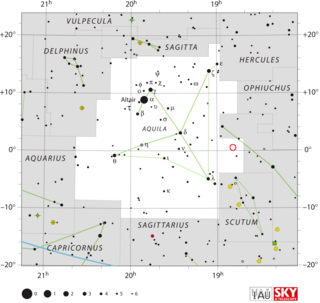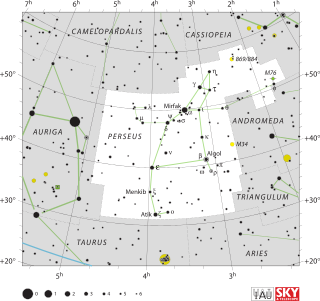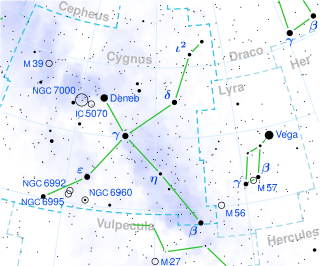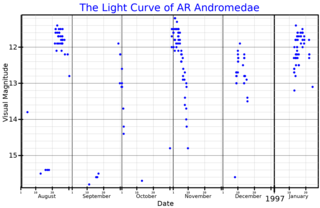
In astronomy, cataclysmic variable stars (CVs) are stars which irregularly increase in brightness by a large factor, then drop back down to a quiescent state. They were initially called novae, since ones with an outburst brightness visible to the naked eye and an invisible quiescent brightness appeared as new stars in the sky.
Soft X-ray transients (SXTs), also known as X-ray novae and black hole X-ray transients, are composed of a compact object and some type of "normal", low-mass star. These objects show dramatic changes in their X-ray emission, probably produced by variable transfer of mass from the normal star to the compact object, a process called accretion. In effect the compact object "gobbles up" the normal star, and the X-ray emission can provide the best view of how this process occurs. The "soft" name arises because in many cases there is strong soft X-ray emission from an accretion disk close to the compact object, although there are exceptions which are quite hard.

V603 Aquilae was a bright nova first observed in the constellation Aquila in 1918. It was the brightest "new star" to appear in the sky since Kepler's Supernova in 1604. Like all novae, it is a binary system, comprising a white dwarf and donor low-mass star in close orbit to the point of being only semidetached. The white dwarf sucks matter off its companion, which has filled its Roche lobe, onto its accretion disk and surface until the excess material is blown off in a thermonuclear event. This material then forms an expanding shell, which eventually thins out and disappears.

T Coronae Borealis, nicknamed the Blaze Star, is a recurrent nova in the constellation Corona Borealis. It was first discovered in outburst in 1866 by John Birmingham, though it had been observed earlier as a 10th magnitude star. It may have been observed in 1217 and in 1787 as well. It is expected to undergo an outburst again very soon; it could erupt again before August 2024.
Z Andromedae is a binary star system consisting of a red giant and a white dwarf. It is the prototype of a type of cataclysmic variable star known as symbiotic variable stars or simply Z Andromedae variables. The brightness of those stars vary over time, showing a quiescent, more stable phase and then an active one with a more pronounced variability and stronger brightening and/or dimming.

R Aquarii is a variable star in the constellation Aquarius.
A luminous supersoft X-ray source is an astronomical source that emits only low energy X-rays. Soft X-rays have energies in the 0.09 to 2.5 keV range, whereas hard X-rays are in the 1–20 keV range. SSSs emit few or no photons with energies above 1 keV, and most have effective temperature below 100 eV. This means that the radiation they emit is highly ionizing and is readily absorbed by the interstellar medium. Most SSSs within our own galaxy are hidden by interstellar absorption in the galactic disk. They are readily evident in external galaxies, with ~10 found in the Magellanic Clouds and at least 15 seen in M31.

SS Cygni is a variable star in the northern constellation Cygnus. It was discovered in 1896 by Louisa D. Wells, a computer working under Edward Pickering at Harvard College Observatory. It is the prototype of the subclass of dwarf novae that show only normal eruptions. It typically rises from 12th magnitude to 8th magnitude for 1–2 days every 7 or 8 weeks. The northerly declination of SS Cygni makes the star almost circumpolar from European and North American latitudes, allowing a large proportion of the world's amateur astronomers to monitor its behavior. Furthermore, since the star lies against the rich backdrop of the Milky Way band, the telescope field of view around SS Cygni contains an abundance of useful brightness comparison stars.

RR Telescopii is a symbiotic nova in the southern constellation Telescopium. It was recorded on photographic survey plates as a faint variable star between photographic magnitude (mpg) 9 to 16.6 from 1889 to 1944. In late 1944 the star began to brighten, increasing by about 7 magnitudes, from mpg ≈ 14 to brighter than 8. Brightening continued with a diminished rate of increase after early 1945, but the overall outburst was not noted until the star was seen at about 6.0, the threshold of naked eye brightness, in July 1948. At that time it was given the designation Nova Telescopii 1948. Since mid-1949 it has declined in brightness slowly, albeit accompanied by some remarkable changes in its spectrum, and as of August 2013 it had faded to visual magnitude around 12.

AG Pegasi is a symbiotic binary star in the constellation Pegasus. It is a close binary composed of a red giant and white dwarf, estimated to be around 2.5 and 0.6 times the mass of the Sun respectively. It is classified as a symbiotic nova; it has undergone one extremely slow nova outburst and a smaller outburst.

DD Microscopii, also known as CD−43°14304, is a binary star system in the constellation Microscopium. The system has a combined average apparent magnitude around 11, making it readily visible in telescopes but not to the naked eye. It is thought to be at a distance of one or two thousand parsecs, although parallax measurements place the system at a distance of around 30,000 light years.

BV Centauri is a cataclysmic variable binary star in the constellation Centaurus. It is a dwarf nova, and undergoes rapid increases in brightness that are recurrent with a mean period of 150 days. This period seems to have increased in the last few decades. During quiescence, its visual apparent magnitude is about 13, with variations of a few tenths of magnitude over an orbit due to differences in the star's visible surface area, brightening to a maximum magnitude of 10.7 during outbursts. From its luminosity, it is estimated that the system is about 500 parsecs (1,600 ly) away from Earth. A Gaia parallax of 2.81 mas has been measured, corresponding to about 360 pc.

SU Ursae Majoris, or SU UMa, is a close binary star in the northern circumpolar constellation of Ursa Major. It is a periodic cataclysmic variable that varies in magnitude from a peak of 10.8 down to a base of 14.96. The distance to this system, as determined from its annual parallax shift of 4.53 mas, is 719 light-years. It is moving further from the Earth with a heliocentric radial velocity of +27 km/s.

V392 Persei, also known as Nova Persei 2018, is a bright nova in the constellation Perseus discovered on April 29, 2018. It was previously known as a dwarf nova.

CH Cygni is a red giant, variable, symbiotic binary in the constellation Cygnus. It is the nearest symbiotic star to Earth, and one of the brightest, making it an ideal candidate for study.

TU Mensae is a cataclysmic variable star of in the constellation Mensa. A close binary, it consists of a white dwarf and low-mass star orbiting each other in 2 hours 49 minutes. The stars are close enough that the white dwarf strips material off the other star, creating an accretion disc that periodically ignites with a resulting brightening of the system. These result in an increase in brightness lasting around a day every 37 days. Brighter outbursts, known as superhumps, last 5-20 days and take place every 194 days. The properties of TU Mensae have been difficult to calculate, as the calculated mass ratio between the two stars mean there should not be superhumps.

AR Andromedae is a dwarf nova of the SS Cygni type in the constellation Andromeda. Its typical apparent visual magnitude is 17.6, but increases up to 11.0 magnitude during outbursts. The outbursts occur approximately every 23 days.

DX Andromedae is a cataclysmic variable star in the constellation Andromeda. It has a typical apparent visual magnitude of 15.5 during the quiescent phase, but becomes brighter during outbursts recurring with a mean cycle length of 330 days, thus is classified as a dwarf nova of the SS Cygni type.

EG Andromedae is a symbiotic binary in the constellation Andromeda. Its apparent visual magnitude varies between 6.97 and 7.80.

V455 Andromedae is a dwarf nova in the constellation Andromeda. It has a typical apparent visual magnitude of 16.5, but reached a magnitude of 8.5 during the only observed outburst.

















